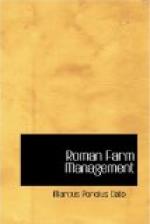Stolo here interrupted. “You will recall,” he said, “that Cato in comparing the different kinds of soil, ranked them by their merit in nine classes according to what they would produce, of which the first was that on which the vine would grow a plentiful supply of good wine; the second that fit for an irrigated garden; the third for an osier bed; the fourth for an olive yard; the fifth for a meadow; the sixth for a corn field; the seventh for a wood lot; the eighth for a cultivated orchard, and the ninth for a mast grove.”
“I know he wrote that,” replied Scrofa, “but every one does not agree with him. There are some who put a good pasture first, and I am among them.”
Our ancestors were wont to call them not prala, as we do, but parata (because they are always ready for use). The sedile Caesar Vopicus, in pleading a cause before the Censors, once said that the prairie of Rosea was the nurse of Italy, because if one left his surveying instruments there on the ground over night they were lost next day in the growth of the grass.[63]
(A digression on the maintenance of vineyards)
VIII. There be those who assert that the cost of maintaining a vineyard eats up the profit. What kind of vineyard? I ask. For there are several: in one the vines grow on the ground without props, as in Spain; in another, which is the kind common in Italy, the vines climb and are trained either separately on props or one with another on a trellis, which last is what is called marrying the vine. There are four kinds of trellis in use—made out of poles, of reeds, of ropes and of vines themselves, which are in use respectively in Falerum, in Arpinum, in Brundisium and in Mediolanum. There are two methods of training the vine on trellises, one upright, as is done in the country of Canusium; the other crossed and interwoven, as is the practice generally throughout Italy. If one obtains the material for his trellises from his own land, the expense of maintaining that kind of vineyard is negligible, nor is it burdensome if the material is procured from the neighbourhood. Such trellis material, as has been described, can be grown at home by planting willows, reeds and rushes, or some thing of that kind; but if you propose to rely on the vines to form their own trellis, then you must plant an arbustum where the vines can be trained on trees, such as maples, which the inhabitants of Mediolanum use for that purpose; or fig trees, on which the people of Canusium train their vines. Likewise there are four kinds of props used for the cultivation of unwedded vines; first, the planted post, which is called ridicum and is best when fashioned out of oak or juniper; second, poles cut in the swamp, and the more seasoned they are the longer they will last, but it is the practice to reset them upside down when they rot out in the ground; third, for lack of some thing better, a bundle of reeds tied together




